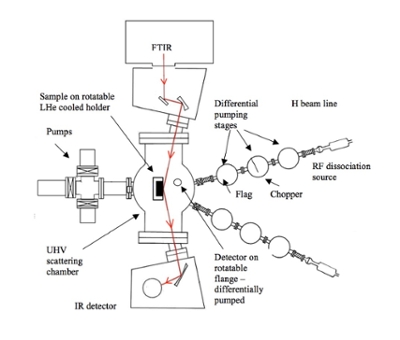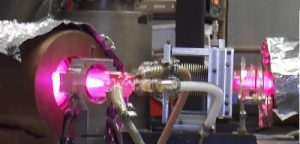Astrophysics & Surface Science

 Description
Description
The apparatus consists of two independent atomic/molecular beam lines, each triply differentially pumped. The pressure in the third stage before the beam enters the main ultra-high vacuum chamber is in the mid 10-9 to low 10-8 torr under operating conditions. Each line has a RF dissociation unit.
The main chamber has an operating pressure of 1-2 10-10 torr. The sample is mounted on a cold finger; a 800K ADR stage allows thermal decoupling of the sample holder from the cold finger during heating at high temperature. The sample holder is mounted on a doubly differentially pumped rotatable platform and on an XYZ sample manipulator.
A quadrupole mass spectrometer is mounted on the bottom double differentially pumped platform. The QMS is housed in a differentially pumped housing. The gas can enter via a back aperture which is used to measure the incoming beam and a front aperture that looks at the sample. To improve the collection of particles entering the detector from the sample, the front aperture is fitted with a Teflon channel (“nose”) which can be placed a few millimeters in front of the sample. Thus, when the sample is heated to release atoms/molecules (as in a Temperature Programmed Desorption) only particles from the sample enter the QMS.
The sample can be heated to 500 K and above for cleaning and cooled down to 7 K for exposure to the beams.
The apparatus is fitted with RAIRS (Reflection Absorption InfraRed Spectroscopy). The infrared beam enters the chamber through an differentially pumped IR transparent window and strikes the surface at a large angle. The reflected signal travels out through another IR transparent window and is detected by a liquid nitrogent detector.
The system is being fitted for REMPI (Resonance Enhanced Multiphoton Ionization), not shown.
Other figures: The two beam lines with hydrogen and deuterium flowing and the radiofrequency on (top) and view of the apparatus (bottom)


